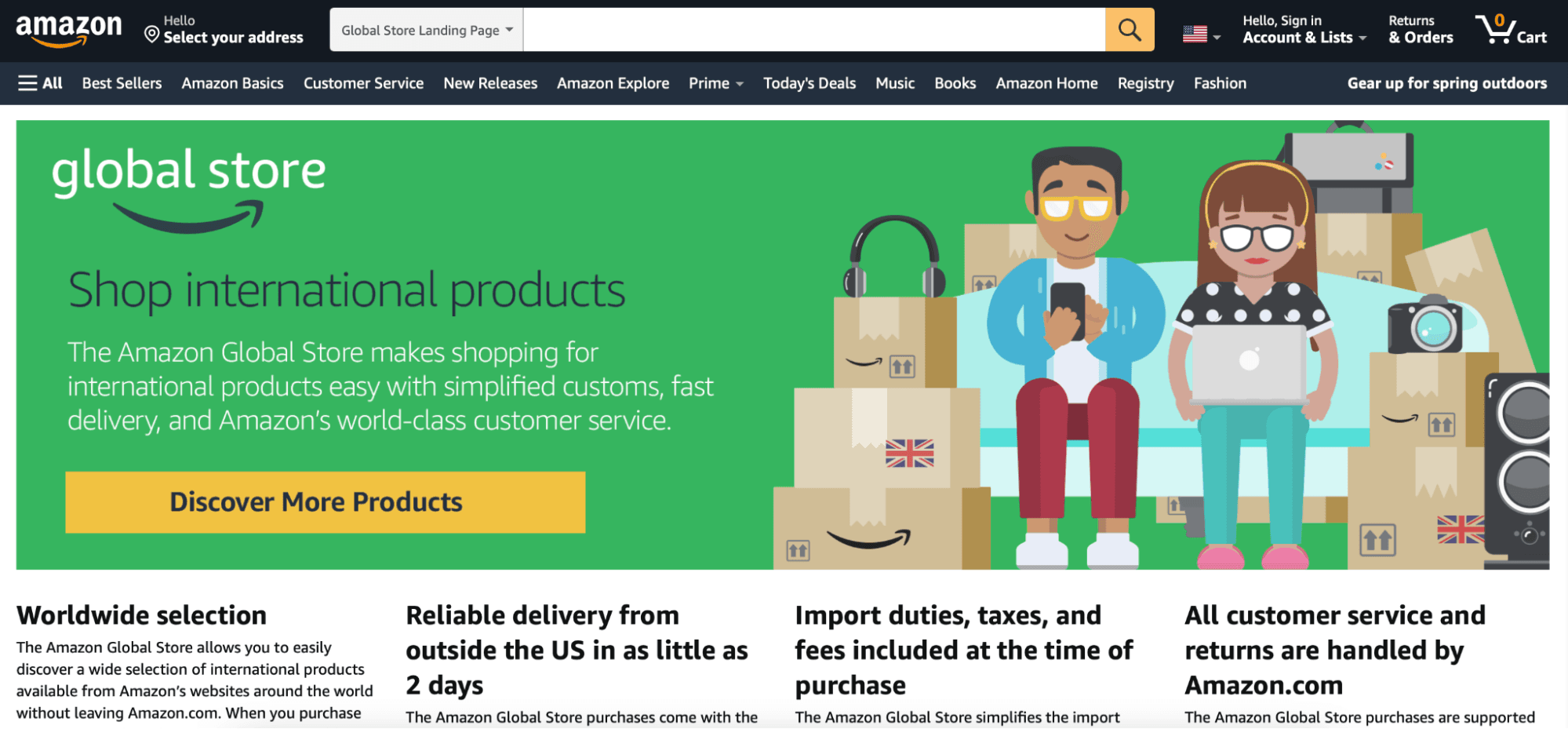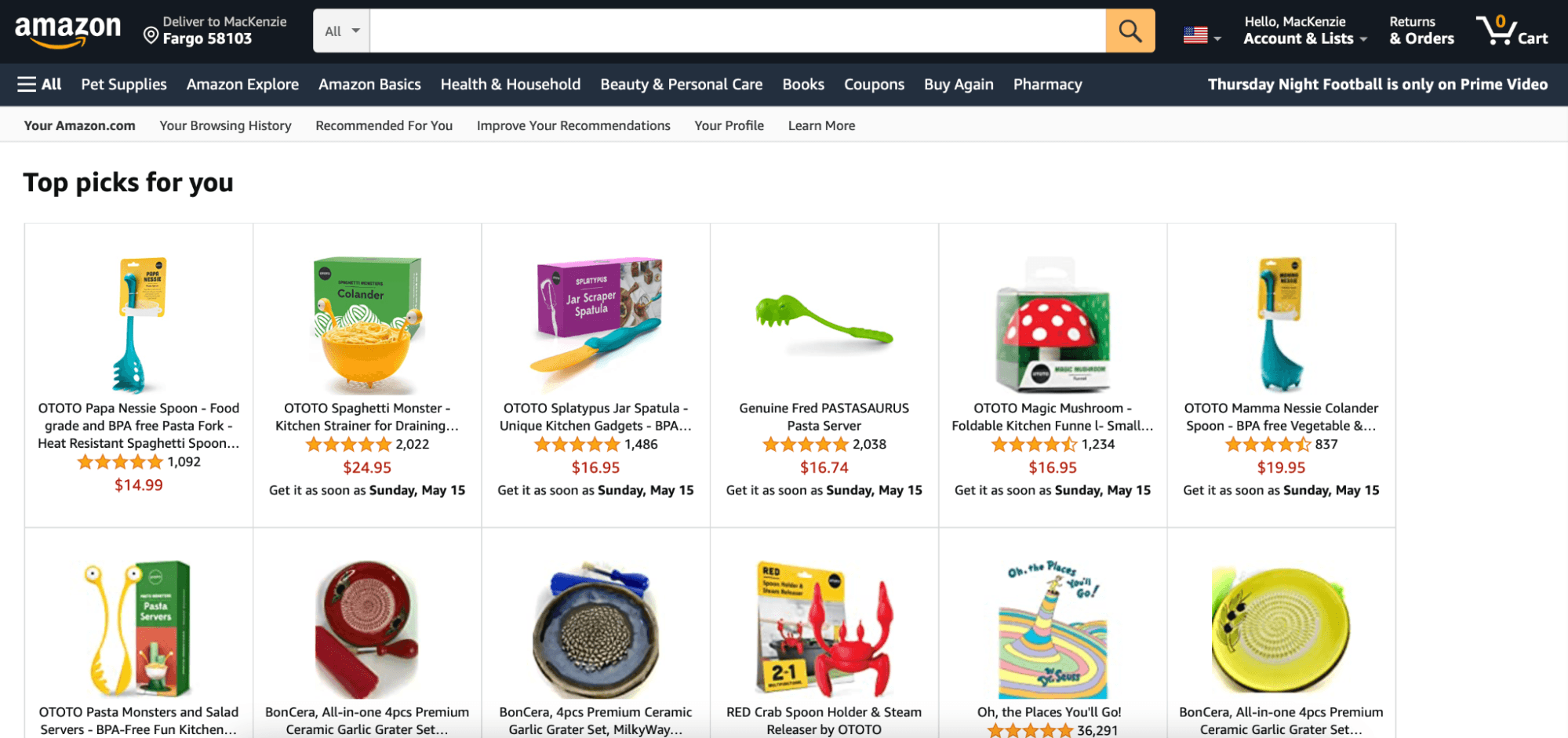Amazon’s marketing strategy has allowed the company to expand rapidly and produce unfathomable revenue throughout the years. From selling books to selling just about everything, this case study explores how Amazon became the eCommerce giant it is today.
This history of Amazon started in 1986 with Princeton graduate Jeff Bezos. Bezos majored in electrical engineering and computer science but soon realized the Internet’s potential for retail purposes.
Bezos planned to open an online bookstore named “Cadabra.” However, after it was misheard as “cadaver,” Bezos decided to name the company after the great South American river.
Amazon was born, and the expansion of Bezos’ vision occurred rapidly. Below are some critical moments in Amazon’s history.
Amazon’s History
- 1995: Amazon opens its doors
- 1997: Bezos makes the company public
- 1998: Product line expands to include CDs, toys, electronics, and tools
- 1999: Bezos is named Times Magazine’s Person of the Year
- 2000: Service introduced that allows outside merchants to sell products on Amazon’s website
- 2003: Amazon’s first full-year profit
- 2005: Amazon begins their loyalty program
- 2007: Amazon produces and debuts the Kindle e-reader
- 2011: Amazon officially sells more ebooks than print books with the launch of Amazon’s tablet computer and Kindle Fire
- 2015: Amazon surpasses Walmart as the world’s most valuable retailer with a market value of $250 billion
- 2017: Bezos named the richest man in the world
- 2021: Bezos steps down as CEO to focus on Blue Origin, his new aerospace company
Early in Amazon’s debut, Jeff Bezos’ motto was “Get big fast,” which he pushed hard to achieve. Even today, expansion is a huge goal for Amazon’s marketing strategy.
Product
As mentioned before, Amazon started out selling only books. However, they quickly expanded to include CDs, furniture, technology, and other products.
Today, Amazon has the widest selection of products among online and offline retailers.
Some of Amazon’s best-selling products include:
- Cookware
- Fashion Items
- Fitness Equipment
- Home Entertainment
- Home Office Furniture
- Laptops
By offering a variety of products and using a unique pricing strategy, Amazon has grown exponentially to defeat competitors. In fact, Amazon orders make up 40% of all online sales within the United States.
Price
Amazon has adopted various pricing strategies to bring customers in and make them unknowingly spend more. Their strategy consists of:
Amazon’s Pricing Strategies
- Cost-Plus Pricing
- Value Pricing
- Price Discrimination
- Psychological Pricing
- Promotional Pricing
Amazon has used a high runner market strategy the most out of all the strategies listed above. This strategy works because Amazon analyzes trends and popular products and then sells them for a discounted price.
After consumers place this discounted item in their cart, Amazon gives them recommendations for accessories. The accessories are marked much higher than their average price, but consumers don’t often recognize the difference.
For example, a phone may have a discounted price. However, the recommended accessories (speakers, headphones, chargers, cases) are priced higher than usual.
Consumers pay the extra cost because they’re distracted by the deal they just received, and they need the accessories anyway.
Place
Amazon started in Seattle, Washington, presumably because there wasn’t any sales tax in the state. Today, the company sells to consumers all over the globe.
Amazon has warehouses throughout the United States. Additionally, the company has expanded to include warehouses in Canada and Germany.
The business launched Amazon Global to allow users to shop internationally from the Amazon website. This initiative expands the products available to customers worldwide.
Promotion
Amazon uses a variety of traditional marketing strategies, including print and digital advertising, when promoting their products. The company also uses sales promotions, product placement, and pay-per-click (PPC) campaigns.
Amazon also created an affiliate program so they can promote their products on different sites, which is mutually beneficial. The program works like this:
Amazon’s Affiliate Program
- An affiliate website has a link directing users to Amazon
- The user makes a purchase from that link within 24 hours
- The affiliate site is paid a portion of the sale
Amazon’s promotion tactics have allowed the brand to become well known throughout the United States. Because of these strategies, very few people haven’t heard about Amazon.
Data-Driven Approach
Amazon allocated a lot of resources into customer research. They wanted to learn consumer shopping habits to target their audience better.
Amazon can report on which habits are popular among frequent buyers. For example, the time someone makes a purchase and how much they paid is tracked for data.
Amazon publishes a consumer behavior report each year to share their findings. Below are the key takeaways from the 2021 report.
These statistics allow Amazon to determine how their marketing strategies work and what they can improve.
Research Consumer Habits
You can copy this aspect of Amazon’s marketing strategy by researching the consumer habits in your industry.
Researching consumer behavior allows you to discover why your customers are buying from you and if there are any blockers. You can also learn where and when to promote your products to reach your target market.
Tips on how to conduct consumer research:
- Define Your Purpose
- Look At Case Studies
- Utilize Social Listening
- Leverage Polls And Surveys
- Analyze Your Data
Customer-Centric Attitude
Amazon has adopted a customer-centric attitude to increase purchases. They offer an easy-to-use customer service site to help customers with various inquiries.
Their mission states Amazon “strives to be Earth’s most customer-centric company, Earth’s best employer, and Earth’s safest place to work.” They adopt this philosophy because they realize the benefit of providing for your customers.
They give each customer personalized recommendations based on their recent browsing history and past purchases. These efforts increase the likelihood of them coming back to make another purchase.
Improve Customer Experience
Customer experience is vital in generating revenue. 89% of consumers are more likely to make another purchase after a positive customer service experience.
Tips on improving customer experience:
- Understand what your customers want
- Analyze customer pain points
- Streamline communication
- Foster personal connections
- Personalize customer experiences
- Listen to customer feedback
Take a page out of Amazon’s marketing strategy and discover how you can improve customer experience in your business.
Emphasizing Technological Growth
Jeffery Bezos is known for wanting to expand into new technological heights. It should be no surprise that this desire has been integrated into Amazon’s marketing strategy.
Early on, when Amazon was selling primarily books, the company decided to try something new. They created the Kindle e-reader, Amazon’s tablet computer, and Kindle Fire.
Eventually, Amazon began selling more eBooks than print books, which opened the doors for them to add other products to their lineup. By focusing on the potential technology has and growing their business in that direction, they’ve found success.
Expand Into A New Niche
You can copy this portion of Amazon’s marketing strategy by experimenting with new niches within your own business. Like Amazon tried developing toward ebooks, you can try diving into specialized aspects of your business.
This effort can help attract a more exclusive audience.
Tips on how to develop niche products for niche audiences:
- Identify Customer Needs
- Check Out Competitors
- Look At Market Gaps
- Prioritize Innovation
- Analyze Trends
Though expanding into new niches can bring more revenue, make sure you don’t ignore your primary market. After all, Amazon continues selling books even though they’ve expanded into other interests.
Promoting User-Generated Content
Perhaps one of the greatest pieces of Amazon’s marketing strategy is the opportunity for customers to post reviews. 93% of people look at online reviews before making a purchase, proving why this strategy is so effective.
Consumers on Amazon frequently leave reviews that include pictures of the product. These reviews help other potential customers determine whether or not they want to purchase the product.
Highlight Your Best Reviews
When you let your products speak for themselves, it seems more reliable. There’s no better way to do that than to highlight the user-generated content that includes the highest praise.
When real people give testimonials about products they love, it can influence other potential customers. This type of content seems more trustworthy because consumers know the person is sharing their actual opinions about their products.
Tips on how to gather reviews and other user-generated content:
- Check out social media
- Monitor comments under the product listing
- Introduce incentives for positive reviews
- Send consumers surveys
- Create quality products
Utilizing Digital Channels
Amazon’s marketing strategy has relied heavily on digital channels to reach partners and customers. Amazon uses social media, associates programs, sponsored search, and email campaigns as part of its strategy.
Amazon’s email marketing strategy involves promoting recommended items, holiday sales, discounts, new arrivals, and more.
Utilizing digital channels allows Amazon to place their advertisements right before their target audience.
Go Where Your Customers Are
This approach works because Amazon knows precisely where their audience is, which means they know where to put their content. You can analyze where your audience is and select the best channels to reach them, too.
These channels can include:
- Social Media
- Print Marketing
- Email Marketing
- Referral Websites
- Word-Of-Mouth
- SEO
- Pay-Per-Click (PPC) Marketing
Remember, you can always add and subtract channels from your strategy depending on what’s performing well. For now, determine which channels will help get your content in front of your audience.
Fostering Partnerships
Amazon has partnered with multiple companies to bring a variety of products to their site. The company has partnered with over 550 different businesses to meet customer demands.
Business partnerships:
- Break up the workload
- Bring unique perspectives
- Give more collaborative visibility
- Defend against internal politics
In the early 2000s, Amazon partnered with Living.com to bring their furniture pieces to Amazon.com. The company has since grown the number of partnerships they are a part of to expand their inventory.
Embrace Collaborations
Amazon’s marketing strategy involves partnering with other businesses to drive sales and connect. You can partner with other companies to gain the same benefits.
Choose to partner with businesses who:
- Have Similar Values
- Have Complimentary Skills
- Understands Your Goals
- Has Clear Goals Of Their Own Outlined
- Communicates Regularly
- Shares Your Vision For The Future
Collaborations should be mutually beneficial. Allow yourself to be transparent about your company goals to choose the right partnership.
Ready to make your Amazon ads stand out? Use the Amazon Ad Generator to create ads that grab attention and boost your sales!
This case study shows that Amazon’s marketing strategy is based on business growth and innovation. Amazon grew by collecting data, expanding product lines, and emphasizing partnerships and customer satisfaction.
By following Amazon’s lead, you can develop your own business that drives you toward success.







